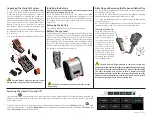
EFERGY RECOMMENDS THAT INSTALLATION IS CARRIED OUT BY A QUALIFIED ELECTRICIAN
EFERGY RECOMMENDS THAT INSTALLATION IS CARRIED OUT BY A QUALIFIED ELECTRICIAN
1. CHOOSE SENSOR TYPE
a) CT sensor
To measure household consumption connect the Mini CT sensor to the feed cable (see
Sensor1 on the diagram bellow). If your electricity panel differs to the one shown here
please contact us at
If you want to measure solar generation connect the Mini CT sensor to the cable coming
from the solar inverter (see Sensor2 on the diagram bellow).
To connect the CT sensor pull the clasp to open it, place the sensor around the feed cable
and push the clasp to shut. Insert the sensor jack in to the base of the transmitter.
UNDERSTAND YOUR HOME ENERGY CONSUMPTION
AND SOLAR GENERATION LIKE NEVER BEFORE
The
engage solar kit
lets you manage multiple circuits in your home from anywhere, any time
through the engage online portal.
This kit is perfect for monitoring your solar generation and comparing it to your energy
consumption info. Instantly see the cost of using energy in your home (updates every 10s).
HOW IT WORKS
Our
engage solar kit
is simple to install and use. One CT sensor is clipped onto the live feed
cable at your breaker panel and another on the cable coming from the solar inverter. These
sensors are then connected to the efergy transmitters. The transmitters wirelessly send real time
data to the hub. The engage hub is connected to your internet router via ethernet cable.
2. CHOOSE TRANSMITTER TYPE
The
engage solar kit
is packaged with either a standard efergy transmitter or a waterproof
transmitter. If you require TPM or IR/Optical transmitters, please visit our website at
www.efergy.com
to purchase.
3. CONNECT THE ENGAGE HUB
a)
Plug the engage hub into a mains power source
using the supplied AC adaptor, and into a spare port
on a router with internet access using the LAN cable
provided.
b)
There are 3 lights on the top of the hub. First, the
red light will light continuously, showing that the hub
is powered on. The yellow light (centre) will come on
next, indicating that the hub is looking for a
transmitter within range. A green light states that a
working internet connection has been connected to
the hub.
c)
Within a minute or two you should see both the
yellow light and green light come on and stay on solid
for a few seconds and then go out. The lights may or
may not illuminate at the same time. Once you see
the yellow and green lights come on for a few
seconds and then go out, you are ready to register
your engage hub.
Note: If your router does not recognize your new hub, the router may
need to be reset. Simply do this by pushing the reset button on the
router itself (sometimes this requires the use of a paper clip).
b) Typical IR/ Optical Sensor Installation (DIY)
Meters generally have an output port located on the front panel. The output port will have
digits in imp/kWh mentioned below it. e.g. 1000 imp/kWh.
Unscrew the sensor body from the sensor base. Peel off the adhesive on the base of the
sensor and position the sensor base hole over the flashing LED
Re-attach the sensor body to the sensor base and screw firmly in place.
Insert the jack on the end of the sensor wire into input socket on the transmitter. The
transmitter will send the information wirelessly to the display.
Note: The
engage solar kit
is packaged with 2 Mini CT sensors. If you require TPM AC / AC
Sensor or IR / Optical sensors, please visit our website at
www.efergy.com
to purchase.
OR
CT Sensor
Breaker Transmitter
CT Sensor
Classic / Waterproof Transmitter
Sensor2
Sensor1
Solar inverter
Electricity panel




















